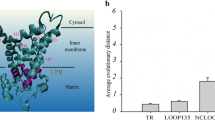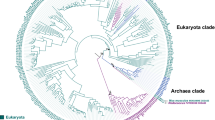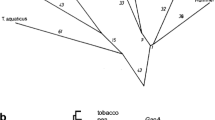Abstract
Creatine kinase (CK) is a member of a group of phosphoryl transfer enzymes called phosphagen kinases that play a key role in cellular energy transactions in animals. Three CK isoform gene families are known—cytoplasmic CK (CK), flagellar CK (fCK), and mitochondrial CK (MiCK). Each of the isoforms has a unique gene structure (intron/exon organization). A broad array of other phosphagen kinases is present in animals. Some of these enzymes are found only in annelids and closely related groups including glyocyamine kinase (GK), lombricine kinase (LK), taurocyamine kinase (TK), and a unique arginine kinase (AK) restricted to annelids. Phylogenetic analyses of these annelid phosphagen kinases indicate that they appear to have evolved from a CK-like ancestor. To gain a greater understanding of the relationship of the CK isoforms to the annelid enzymes, we have determined the intron/exon organization of the genes for the following phosphagen kinases: Eisenia LK, Sabellastarte AK, and Arenicola mitochondrial TK (MiTK). Analysis of genomic database for the polychaete Capitella sp. yielded two putative LK genes [cytoplasmic LK and mitochondrial LK (MiLK)]. The intron/exon organization of these genes was compared with available data for cytoplasmic and mitochondrial CKs, and an annelid GK. Surprisingly, these annelid genes, irrespective of whether they are cytoplasmic (LK, AK, and GK) or mitochondrial (MiTK and MiLK), had the same 8-intron/9-exon organization and were strikingly similar to MiCK genes sharing seven of eight splice junctions. These results support the view that the MiCK gene is basal and ancestral to the phosphagen kinases unique to annelids.




Similar content being viewed by others
Abbreviations
- CK:
-
cytoplasmic creatine kinase
- fCK:
-
flagellar creatine kinase
- MiCK:
-
mitochondrial creatine kinase
- TK:
-
cytoplasmic taurocyamine kinase
- MiTK:
-
mitochondrial taurocyamine kinase
- LK:
-
cytoplasmic lombricine kinase
- MiLK:
-
mitochondrial lombricine kinase
- GK:
-
glycocyamine kinase
- AK:
-
arginine kinase
- HTK:
-
hypotaurocyamine kinase
References
Bertin M, Pomponi SM, Kokufuta C, Iwasaki N, Suzuki T, Ellington WR (2007) Origin of creatine kinase isoforms: Insights from basal metazoans. Gene 392:273–282
Ellington WR (1989) Phosphocreatine represents a thermodynamic and functional improvement over other muscle phosphagens. J Exp Biol 143:177–194
Ellington WR (2001) Evolution and physiological roles of phosphagen systems. Ann Rev Physiol 63:289–325
Ellington WR, Suzuki T (2006) Evolution and divergence of creatine kinases. In: Vial C (ed) Molecular Anatomy and Physiology of Proteins – Creatine Kinase. NovaScience, New York pp 1–26
Ellington WR, Suzuki T (2007) Early evolution of the creatine kinase gene family and the capacity for creatine biosynthesis and transport. In: Salomons G, Wyss M (eds) Creatine and Creatine Kinase in Health and Disease, Subcellular Biochemistry, vol. 46. Springer Verlag, New York, pp 17–26
Ellington WR, Yamashita D, Suzuki T (2004) Alternative splicing produces transcripts coding for alpha and beta chains of a hetero-dimeric phosphagen kinase. Gene 334:167–174
Klein SC, Haas RC, Perryman MB, Billadello JJ, Strauss AW (1991) Regulatory element analysis and structural characterization of the human sarcomeric mitochondrial creatine kinase gene. J Biol Chem 266:18058–18065
Mühlebach SM, Gross M, Wirz T, Wallimann T, Perriard J-C, Wyss M (1994) Sequence homology and structure predictions of the creatine kinase isoenzymes. Molec Cell Biochem 133/134:245–262
Pineda AO Jr, Ellington WR (2001) Organization of the gene for an invertebrate mitochondrial creatine kinase: comparisons with genes of higher forms and correlation of exon boundaries with functional domains. Gene 265:115–121
Qin W, Khuchua Z, Cheng J, Boero J, Payne RM, Strauss AW (1998) Molecular characterization of the creatine kinases and some historical perspectives. Mol Cell Biochem 184:153–167
Schlattner U, Tokarska-Schlattner M, Wallimann T (2006) Mitochondrial creatine kinase in human health and disease. Biochim Biophys Acta 1762:164–180
Sona S, Suzuki T, Ellington RW (2004) Cloning and expression of mitochondrial and protoflagellar creatine kinases from a marine sponge: Implications for the origin of intracellular energy transport systems. Biochim Biophys Res Commun 317:1207–1214
Suzuki T, Kamidochi M, Inoue N, Kawamichi H, Yazawa Y, Furukohri T, Ellington RW (1999) Arginine kinase evolved twice: Evidence that echinoderm arginine kinase originated from creatine kinase. Biochem J 340:671–675
Suzuki T, Yamamoto Y, Umekawa M (2000) Stichopus japonicus arginine kinase: gene structure and unique substrate recognition system. Biochem J 351:579–585
Suzuki T, Mizuta C, Uda K, Ishida K, Mizuta K, Sona S, Compaan DM, Ellington WR (2004) Evolution and divergence of the genes for cytoplasmic, mitochondrial and flagellar creatine kinases. J Mol Evol 59:218–226
Trask RV, Strauss AW, Billadello JJ (1988) Developmental regulation and tissue-specific expression of the human muscle creatine kinase gene. J Biol Chem 263:17142–17149
Uda K, Suzuki T (2007) A novel arginine kinase with substrate specificity toward D-arginine. Protein J 26:281–291
Uda K, Iwai A, Suzuki T (2005a) Hypotaurocyamine kinase evolved from a gene for arginine kinase. FEBS Lett 579:6756–6762
Uda K, Saishoji N, Ichinari S, Ellington WR, Suzuki T (2005b) Origin and properties of cytoplasmic and mitochondrial isoforms of taurocyamine kinase. FEBS J 272:3521–3530
Uda K, Tanaka K, Bailly X, Zal F, Suzuki T (2005c) Phosphagen kinase of the giant tubeworm Riftia pachyptila. Cloning and expression of cytoplasmic and mitochondrial isoforms of taurocyamine kinase. Int J Biol Macromol 37:54–60
Uda K, Fujimoto N, Akiyama Y, Mizuta K, Tanaka K, Ellington WR, Suzuki T (2006) Evolution of the arginine kinase gene family. Comp Biochem Physiol Part D. Genomics and Proteomics 1:209–218
Wyss M, Smeitink J, Wevers RA, Wallimann T (1992) Mitochondrial creatine kinase: a key enzyme of aerobic energy metabolism. Biochim Biophys Acta 1102:119–166
Wallimann T, Wyss M, Brdiczka D, Nicolay K, Eppenberger HM (1992) Intracellular compartmentation, structure and function of creatine kinase isoenzymes in tissues with high and fluctuating energy demands: the ‘phosphocreatine circuit’ for cellular energy homeostasis. Biochem J 281:21–40
Acknowledgments
We thank Daisuke Yamashita for his help at an early stage of this work. This work was supported by grant-in-aids for scientific research in Japan to T. S. (17570062) and by the US National Science Foundation grants IOB-0130024 and IOB-0542236 to W. R. E.
Author information
Authors and Affiliations
Corresponding author
Rights and permissions
About this article
Cite this article
Tanaka, K., Uda, K., Shimada, M. et al. Evolution of the Cytoplasmic and Mitochondrial Phosphagen Kinases Unique to Annelid Groups. J Mol Evol 65, 616–625 (2007). https://doi.org/10.1007/s00239-007-9046-4
Received:
Revised:
Accepted:
Published:
Issue Date:
DOI: https://doi.org/10.1007/s00239-007-9046-4




